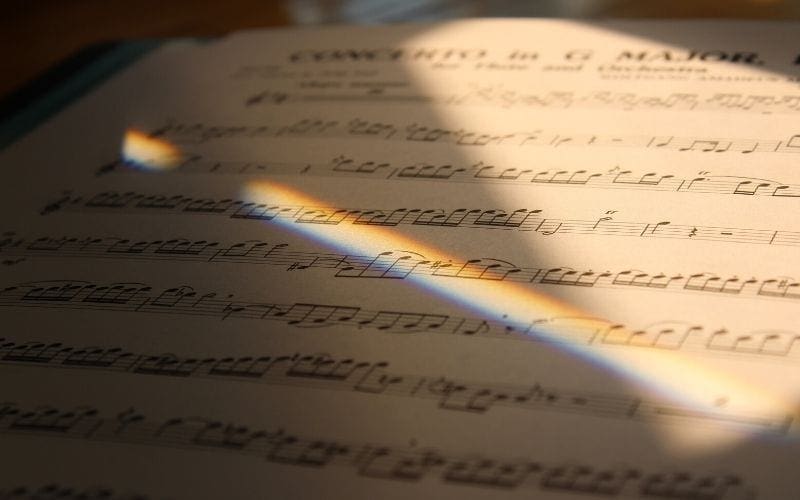Intervals shape the music we listen to every day. The way a melody sounds and the structure of a chord are all dictated by music intervals. It’s not only key in understanding how they work throughout music, but how to name intervals in music by ear.
In this overview, we’ll be taking a look at the most common intervals used in western music, as well as how to train yourself in identifying intervals in music. So if you’ve always wanted to understand and learn music intervals, this is the article for you!
What Is A Music Interval
Simply put, an interval is a distance between two different musical notes. You may have heard the saying Half-Step or Whole-step or Semitone and Tone, this is referring to intervals! The idea of a half-step, when looking at a piano or sheet music, is by simply moving up one. For example, that’s C to C# or E to F. When thinking about a whole step, just add one more key, C to D or E to F#. On the Guitar, it’s the same logic but you move in frets.
We measure intervals by the distance from the starting note, or the ‘Tonic’, to the note we land on. So C to E would be a 3rd as you take 3 steps to get there. C to F is a fourth and so on. If this is seeming a bit confusing right now don’t worry, we’ll be going over all of these later and will have examples for each.
Harmonic Or Melodic?
Intervals can be represented in two different ways, melodically (melody) or Harmonically (harmony). As implied by their name, the difference between them is simply represented by whether they are played on top of each other or whether they are played individually. It is important when interval training for music to practice both types.
Knowing these terms can be a great piece of knowledge when communicating with band members or other musicians. For example, you might want to let your guitarist know that in the chorus of your song, you’ll be stepping up the C Major pentatonic (C, D, E, G, A) melodically for 8 bars, and then adding a 5th to that harmonically (CG, DA, EB, GD, AE,) for the next 8 bars.

Types Of Intervals In Music
We’ll be covering the most popular intervals for right now, spanning the octave. While there are other intervals to be covered, these will be most frequented in common situations in a variety of music from Pop to Jazz to Metal and more. Once you get a hang of these, use that knowledge to start learning other intervals in music!
You may be wondering how to find intervals in music or hear them for that matter, so we’ve also added some example songs to remember musical intervals with! If you want to know how to remember music intervals, then using these song examples is probably one of the best ways.
2nds
We’ve already talked about Whole-steps and Half-Steps above, but they can also be referred to as 2nds. The Minor second, Half-Step(Semitone), or Flat second(b2) is the smallest musical interval you can have in western music. It can be represented by simply moving up one key on the piano or one fret on the guitar.
A good place to hear an example is the ever-popular Jaws Theme.
Listen to the initial buildup (Duh-Dum, Duh-Dum, Duh-Dum) and you’ll get a great reference point.
Diatonic Or Chromatic? (Enharmonic?)
Before we dive into Major 2nds (Whole-Steps), I want to talk about the difference in movement in terms of Diatonic and Chromatic Half-Steps.
Diatonic
Diatonic half-steps are when a note moves up a half-step and changes the note name. For example, C going to Db or E going to F.
Chromatic
Chromatic half-steps are the opposite, like when a note moves up a Half-Step and continues to have the same Tonic name. C going to C# or F going to F#.
The only other instance is what we call an Enharmonic interval. This is when you change the note name but remain on the same key. Such as C# going to Db. This occurrence is very rare and not likely to come up in many contexts outside of key changes.
A Major second is a Whole-Step away from the Tonic and creates the first “Major” interval we have. Being a Major interval simply implies that the note belongs to the major key of the Tonic. In the key of C (C-D-E-F-G-A-B-C), this would be D.
A good reference is a Happy Birthday To You. The first four notes in this melody start on the tonic and move up a major second, and then back down. Try to sing it and pick out each tone.
3rds
Thirds are particularly important intervals, as they help relate to us the tonality of a melody or chord. Simply put, they can help identify if a song is major or minor.
A b3 or Minor third is, as the name insists, a key part of the minor chord. It is Three Half-Steps away from the Tonic.
Relative to the C scale, it would be C to Eb. Most of the guitarists out there right now are probably familiar with the Minor third even if they have never heard of it. Using the Minor Pentatonic scale (C, Eb, F, G, Bb) your first interval is in fact that minor third! You see this all over blues, rock, metal, and pop.
A great reference is the first two chords in Smoke On The Water:
A Major third, as the name implies, is fundamental in the shaping of a Major melody or chord. It is 4 Half-Steps away from the Tonic.
My favourite reference is When The Saints Go Marching In
The first two notes played are a Major Third apart. Sing the beginning of the melody and then slowly take away notes until you have just the interval.
4ths
A 4th or Perfect Fourth is our first step into the world of “Perfect” Intervals. Being a “Perfect” interval just points to the fact that these tones have a high degree of consonance or compatibility. The Perfect intervals are the Perfect 4th, 5th, Octave, and Unison. These are also called P4, P5, P8, P1.
The P4 is 5 Half-Steps away from the Tonic.
My go-to is always the Wedding March:
The exact spot is right when the melody takes off, “Here comes the bride”, sing this and then just go back and forth with those two tones.
Tritone
Between the P4 and P5 (Perfect 4th and 5th) is an interval called a Tritone. You can label this as a #4 or b5, but either way it is still a Tritone. Some common chords using this once-called evil interval are the Maj7(#11) (C, E, G, B, F#) or the Min7(b5) (C, Eb, Gb, Bb). The Tritone is 6 Half-Steps from the Tonic.
Tritones are dissonant and not used in many pop settings, but when you explore other genres from Blues to Jazz, you’ll start to hear them more and more.
My favourite example is Black Sabbath:
You’ll hear it kick right in with the music. It’s noticeably evil-sounding which is why it can be heard all over hard rock and metal, but it takes a much more delicate approach when working with Jazz.
5ths
The Perfect 5th is a key player in modern music and a staple for any rock band. If you have learned any music by The Ramones, you’ve played 5ths or “Power Chords” for probably the majority of the song. The 5th is 7 Half-Steps from the Tonic.
My go-to reference is the Star Wars Theme
You’ll hear it kick off right after the buildup. Sing it out loud and then go back and forth between the two tones.
6ths
A lesser-used interval in pop chords, the sixth adds a different characteristic that can colour your composition very nicely. The Minor Sixth, or b6, is 8 Half-Steps away from the Tonic. This interval could also be referred to as a #5 when dealing with Augmented Chords, but we’ll step into those another time.
My favourite way to think about this is through the famous standard, Black Orpheus
You’ll hear it in the first two notes of the melody.
The Major 6th is just one step higher, so 9 half steps away from the tonic.
The reference I enjoy is the Nursery rhyme, Hush Little Baby
7ths – M7, b7
The last of our intervals inside the octave will be the sevenths. These are my favourite intervals, as they add a dynamic only matched by the 3rds. You’ll find these intervals as a key players in every Jazz Standard.
The b7 or minor 7th is 10 Half-Steps away from the tonic. You’ll find this extremely useful in most Funk contexts, but also a major player in spicing up any regular minor chords.
A good reference for this is the winner takes it all by ABBA:
A Major 7th can be pretty dissonant by itself, but put into context it is a beautiful interval that litters the pages of Jazz standards. It is 11 Half-Steps up from the Tonic (One note away from the Octave)
My go-to Reference is Take On Me by a-ha
The interval is right when the chorus kicks in. Try singing it, then going up to the octave (One note higher).
Octave
The Octave, or P8, or 8ve, is the same note up to 12 half-Steps (C to C). Being able to recall this interval from anywhere will be a testament to your continued learning and will help you find those other higher intervals such as the 6th and 7th.
Check out Eric Clapton doing a take on Somewhere Over The Rainbow
That big Some – Where is right where the octave lands.
Unison
As the name tells you, Unison or P1 is just the same note!
Interval Table Music
Now, we appreciate that that was a lot of information, so here is an overview of the intervals and how many steps they are and what song you can use to remember each one by.
| Music Interval Name | Musical Interval Calculator | Music Interval Songs |
| Unison | 0 steps | |
| Minor 2nd | 1 Halftones | Jaws |
| Major 2nd | 1 Whole tones | Happy Birthday |
| Minor 3rd | 3 Halftones | Smoke On The Water |
| Major 3rd | 2 whole tones | When The Saints |
| Perfect 4th | 5 Halftones | Wedding March |
| Tritone | 3 Whole tones | Black Sabbath |
| Perfect 5th | 7 Whole tones | Star Wars |
| Minor 6th | 4 Whole tones | Black Orpheus |
| Major 6th | 9 Halftones | Hush Little Baby (Lullaby) |
| 7th | 5 Whole tones | The Winner Takes It All |
| 8th | 11 Halftones | Take On Me |
Tips And Tricks
Ear training is an integral part of practising music, and if it’s not in your daily practice routine then it should be!
To start incorporating it, simply learn the Major Scale (C-D-E-F-G-A-B-C), and be able to sing it up and down while naming notes. Once you start to feel comfortable in this area, start picking out intervals in the major scale and play them, sing them, name them, and test yourself.
After this, you can start incorporating intervals outside of the major scale and see how you do. Go slow and take your time learning each of these parts, Rome wasn’t built in a day!










